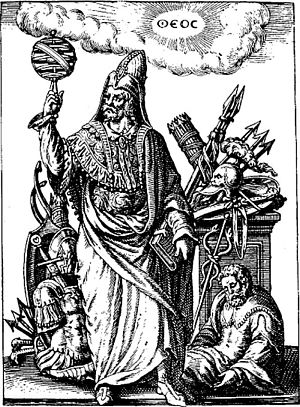
Hermetics is the teachings of the Hermeticists. The study of Hermetics often derives from a series of documents referred to as Hermetica. The first of these are from around 0-400CE, which explain nearly everything from Egyptian paganism, to medical science of the time, philosophy, and even the new science of Alchemy. The earliest chunk of documents was written in Greek and based in Egypt. They show some fear of the abolishment of Egyptian religion and some are for it so it’s not all a homogenous belief. A translation of a large collection of these in the 15th century into Latin which is called the Corpus Hermeticum (or the Hermetic body) reads like a gradual unfolding of mysteries including individuals speaking with the mind, that is perceiving the entire universe and dreaming it into existence. The text often claims to be written by Hermes Trismegistus (or Hermes the thrice great) from whose name Hermetics is taken. These ideas seem to be influenced by Neoplatonism, Gnosticism, and Egyptian paganism. As time goes on new documents begin to appear that are influenced by these, but mysticism is a trait that disappears and alchemy and medical sciences become more prominent. At first, Hermetics is accepted in Christian society because of the singular mind dreaming the universe and a mistranslation of one of the god names as “the Shepheard” led them to believe it was a Christian revelation for pagans, but they later repressed it when they actually read it. It survived through Islamic lands as a form of science though it was often associated with Sufism and later repressed in Islamic lands too, but before that could happen a major collection of alchemical knowledge written by Jabir ibn Hayyan was translated into Latin as Geber and expanded on around 13th century about 500 years after his death. The science of alchemy continued to develop, but there seemed to be two very different branches emerging, those that were entirely concerned with chemical operations and those that seemed to not follow chemical reactions at all. It was deemed that the second lot described a process of soul transformation from a heavy lead soul to a precious golden soul. In the modern day, people who study these documents and attempt to bring about the soul change are called Alchemists. Due to the complicated knowledge required actual alchemy is often deemed undesirably difficult, so frequently historically based alchemical practices do not sell books or courses, whereas simple visualisation exercises often involving chakras move better especially if they stroke the reader’s ego. Slowly this means real alchemy is slowly getting replaced with puff thanks to market forces.
Other famous alchemists include Hypatia, Mary the Jewess, Albertus Magnus, Roger Bacon, Heinrich Cornelius Agrippa, Dr John Dee, Elias Ashmole, Nicholas Flamel and Sir Isaac Newton.
Rosicrucians
In the 1500s a group was rumored to appear called the Rosicrucians. Their most renowned symbol is the rose on the Christian cross. Rumors surrounding the group suggested they had mystical powers derived from a mixture of Christian Qabalah and Soul Alchemy. While very little evidence of the group’s real existence at the time has been found other than the manifesto and a letter to those wishing to join, many groups have tried to recreate this group since the 1500s, some such groups had success for many years. In the modern day, many Rosicrucian groups seem to exist under the umbrella of Freemasonry. Nearly all such groups impart divine knowledge through a series of initiations like the mystery cults of Ancient Greece and Rome.
In Liber ABA : Magick (Book 4), the author (probably dictated to by Aleister Crowley) suggested that most Rosicrucian orders were false recreations and should not have assumed the name. Even S. Mathers’es Rosicrucians, he felt, followed the light that remained after the group had been cut off from its spiritual source. However his only way to judge an order is whether it accepted his new Law of Thelema.
The Hermetic Order of the Golden Dawn
The Hermetic Order of the Golden Dawn is the most well known order to teach Hermetics. It also teaches Qabalah and Theurgy. Some of the initiation rituals are named after the eleged creator of the Rosicrucians Christian Rosenkreuz. The order began in the 1880s. Aleister Crowley was initiated in this group. After splintering because of political difficulties it inspired a second group with the same rituals called the Stella Matutina. By the 1930s the order was mostly closed and dead except one group in New Zeland which operated until 1978 and some friends who met ocassionally in Bristol. In 1982 a group began in the states who tried to recreate the group from records and publications of Israel Regardie an initiate of the Stella Matutina. Israel Regardie consecrated their temple and imparted the first initiations. Today 3 groups exist claiming to be a continuation of the Hermetic Order of the Golden Dawn. One is the temple mentioned above. One was made by an initiate in the New Zeland group who only obtained a few of the degrees and a third from someone who has little to do with any previous groups, but focuses on simple easy-to-do practical magic.
The original Hermetic Order of the Golden Dawn boasted some interesting membership including the authors of Sherlock Holmes and Dracula, Sir Arthur Conan Doyle and Bram Stoker. It also included famous playwrights and actresses of the time. Also, Sir John Woodroffe and Charles Henry Alan Bennet, that were credited with first bringing Tantra and Buddhism to the west respectively.
See also other types of Magical Practitioner.

Comments
2 responses to “Hermeticists, Alchemists and Rosicrucians”
[…] Hermeticist / Alchemist / Rosicrucian […]
[…] the Initiatory Order the Hermetic Order of the Golden Dawn, the 3rd initiation which is called Theoricus 2=9 the initiate goes from a grade associated with […]